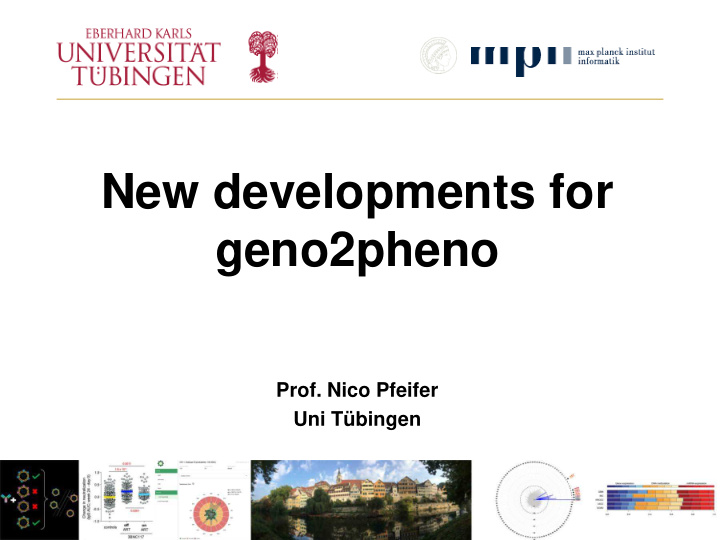



New developments for geno2pheno Prof. Nico Pfeifer Uni Tübingen
Excellence cluster: “Machine Learning: New Perspectives for Science” (Tübingen) 3
Biomedical Data Science
Biomedical Data Science Coding skills are necessary for working with massive amounts of electronic data that must be acquired, cleaned, and manipulated. Coding Skills 5
As transformative as electricity was?
Nature (2017) doi:10.1038/nature21056 ~130,000 labeled images to train the model
Machine Learning • What can Machine Learning methods solve? –“Everything “
Machine Learning • What can Machine Learning methods solve? –Andrew Ng: “Everything a human can do in a second” (low hanging fruits) • Automation of certain processes – Classification: Spam / no spam – Scene understanding: object recognition in pictures/videos – Text translation: English – German – Predict wait times: Pizza delivery
Machine Learning in Medicine • What could Machine Learning methods solve (harder cases)? –Predict therapy success • Complex data, but simple phenotype (e.g., therapy success / failure) • Find predictors in complex data to predict success or failure early during course of the disease • Provide interpretable results for treatment decision support
Treatment Decision Support System (TDSS) for HIV- infected patients • Prime example of personalized medicine: • Many different drugs available • Drugs are given in combination (>2) • Drug resistance mainly depends on genotype of virus (small genome) • Large data collections have been established to enable training the machine learning algorithms (AREVIR, EuResist, ...) T. Lengauer, N. Pfeifer, R. Kaiser, Personalized HIV therapy to control drug resistance. Drug Discov. Today Technol. 11, 57–64 (2014).
If we have NGS data https://ngs.geno2pheno.org/ 12
Treatment decision support systems for NGS data from HIV/HCV Döring M., …, Rolf Kaise, Thomas Lengauer, and Pfeifer N. Nucleic Acids Research 2018, gky349 13
Treatment decision support systems for NGS data https://ngs.geno2pheno.org/ 14
Server for HIV resistance prediction against bNAbs geno2pheno[bNAbs] 15
Based on http://journals.plos.org/ploscompbiol/issue?id=10.1371/issue.pcbi.v13.i11#Cover A. Hake and N. Pfeifer, PLOS Computational Biology 2017, 13(10):e1005789 16
Estimated tuberculosis cases and deaths, 2017: Estimated mortality of TB cases (all forms, excluding HIV) per 100,000 population 17
Notified MDR/RR-TB Cases absolute numbers 18
• Project runs for 2 years • brings together 12 partners from 10 countries that are led by EuResist Network (Italy). • Centre of Excellence for Health, Immunity and Infections (CHIP, Denmark) is responsible for scientific coordination of the project. • CARE operates under a specific Horizon 2020 call aiming to foster research between the EU and the Russian Federation. 19
Kick off meeting in Rome 1/2019 20
Kick off meeting in Rome 1/2019 21
Geno2pheno[TB] • Start with existing data / existing rules – Collaboration with Borstel (Leibniz Center for Medicine and Biosciences) • Build customized version for Eastern Europe – Transfer Learning with general model and newly generated data from St. Petersburg and Chisinau 22
Future of geno2pheno • [ngs-freq]: Predict treatment success from NGS data directly – Use linkage information between positions for more accurate models – Get rid of “expert” cut-offs – Differentiate functional from non-functional viral variants • [ngs-freq]: Include host information – Some HLA footprints overlap with positions predictive for treatment success • [bNAbs]: Optimize for clinical use case • Prediction methods for other diseases: TB, HCV, … 26
Treatment decision support systems • More and more data can be measured (e.g., different omics layers) • Data is available for more and more diseases (see medical informatics initiative) • We need efficient machine learning / data mining methods to learn association between treatment and patient outcome • Results need to be communicated in a transparent and interpretable form
Thanks to everybody, especially: Matthias Döring Thomas Lengauer Florian Klein Anna Hake Rolf Kaiser Till Schoofs Joachim Büch Francesca Incardona Jan Heyckendorf Georg Friedrich Marius Herr Come visit us at our new place
Recommend
More recommend